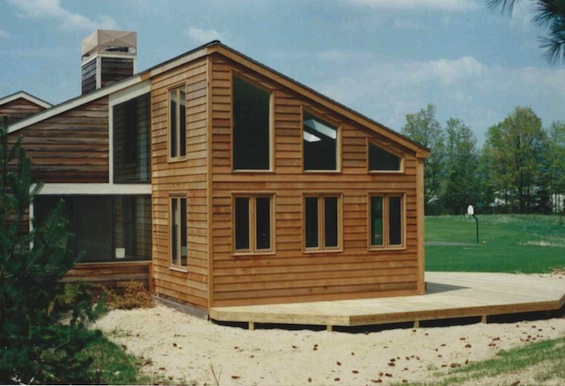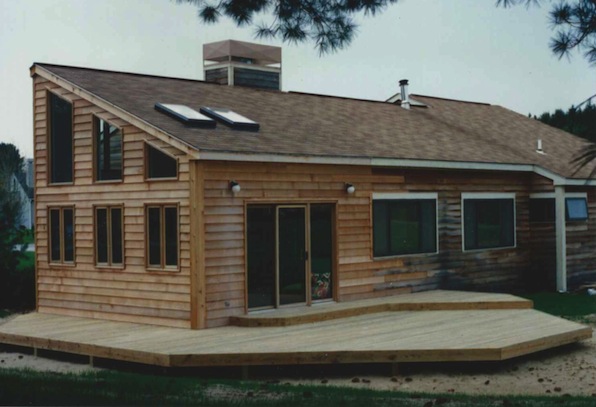
Our Homes and the Earth
Buildings, statistically, are the largest consumers of earth's resources - both material and energy. As most of these resources are limited, it is critically important to use them wisely. Even though we have known this for a long time, it is sometimes difficult to overcome traditional habits of thought which we have grown up with regarding our homes and our needs for space and comfort.
At New Leaf Design, we encourage our clients to think very carefully about their needs, and to look for ways to minimize their personal impact on the environment. This is not simply a matter of using "green" building materials in their homes. It is a matter of thinking about their relationship to the earth and their community such that the way they live enhances rather than impacts the world around them. This does not mean a Spartan or austere way of life. It means instead making thoughtful and creative choices about what we need and how we want to live, looking closely at what enhances our lives, and what are the costs and benefits of our use of limited resources. Resources, again, are not just materials; they include land, undisturbed nature, community energy - even time, which for all us is limited.
The Design Process

Any building project, whether it is a bookshelf or a house, a flower pot or a garden, begins in design, and design begins in intent. In order to design properly, we must first ask:
- What do we want?
- What do we need?
- What will enhance our lives?
- What will enhance this particular place?
- What will enhance the future?
But this is just the beginning. The design process begins with a first glimpse of possibility, an often awkward fitting together of disparate elements, wishes, and opportunities. But, if it is to be really successful, this limited beginning will broaden into a discovery of new possibilities, new creativity, new leaps of consciousness.
Design is ultimately a synergy that occurs between designer and client in which the best opportunities and qualities of a particular location, space, (or perhaps a limiting circumstance) are discovered, and worked with imaginatively to bring about the best possible outcome. The designer applies his best skills and knowledge about site development and building. The clients are encouraged to fully explore their own needs and wishes for space and living style and happiness, and to be creative in their thinking as well. When the process is really working, imagination and a mutual awareness take over both parties and something really extraordinary unfolds.
Design and Energy Use
The average home built in the Northeast today uses almost 120 million BTUs - in heat, domestic hot water, cooking fuel, lighting, and appliances - each year. That is the equivalent of over 35,000 kilowatt hours of electricity, 866 gallons of fuel oil, 1,304 gallons of propane, or 117,647 cubic feet of natural gas. Depending on the fuels used in this house, it will send fifteen to twenty-two thousand pounds of carbon dioxide into the atmosphere each year.
Yet it is now possible, and at reasonable cost, to build new homes that require as little as five or less kilowatt hours per square foot of total energy annually. For a 1500 square foot home, that is less than 7,500 kilowatt hours or 25 1/2 million BTUs total per year. Coupled with on-site renewable energy technology, these homes can become net producers of clean energy for our communities.
Why this enormous disparity?
A large part of it is contained in traditional economic assumptions about what a house should cost to begin with, and what it should cost to maintain. The high efficiency home may cost approximately thirty percent more than the same house with average energy usage. If the latter costs $200,000 to build, the former may cost $260,000. Yet, with renewable energy systems in place, the former will have annual energy bills of at most a few hundred dollars (and probably way less), while the latter will be closer to $3,500. Paying the difference in a mortgage with deductible interest, or using investment funds for an annual return of over $3,000 would make sense to any financially minded homeowner. Furthermore, the quality, and therefore the value, of the higher efficiency home will also hold up better over time and will maintain its value whenever it is sold.
The first step in designing or making over a home - before we even begin to lay out rooms or consider the envelope is to look at how the home can enhance or diminish certain elements of our lifestyle integrity.

- What do we do when we are at home?
- How does light and air affect our well-being?
- How can we bring the out-of-doors surroundings of the house inside?
- Who will be living in the house?
- How much space do we need when we are together?
- How much space do we need when we wish to be apart from one another?
- How can we make these spaces more concise without making them more confining?
Solutions within the context of energy or resource impacts would include reducing the amount of space we need without reducing our comfort in that space or limiting our imagination in how we use that space. It would include understanding and facilitating our personal rhythms and managing our personal traffic patterns, allowing us to appreciate the things - tools, implements, textures, colors, arrangements, fabrics, containers, and other personal elements - that we value, without providing space that simply becomes a warehouse or a catchall for more stuff.
Once this is done, we can look at the opportunities provided by the building site (or the existing home) - on-site energy potential, light orientation, air, silence, wildlife potential (including insects), land character - with a close eye on what should be preserved, what can be enhanced, and what can be utilized.
The question is simple: What is the special benefit of living in this particular place in the world?
Energy Use and Our Future
Traditional reliance on fossil fuels and other environmentally destructive practices is really a product of stubborn habits of thought coupled with lack of imagination. We have in place both the ingenuity and the technology to eliminate - or at least radically minimize - our dependence on fossil fuels. Yet our cultural resistance to doing so on a large scale - which is a product largely of political and market manipulation by powerful industries invested in those same fossil fuels - continues to hamper our capacities to advance into a fully renewable based economy and lifestyle.
To shift the culture - to make the personal changes to lead us - in the direction of broader scale renewable energy will take much personal will and personal transformation on the part of many individuals and families. This is not a matter of simply telling ourselves to make these changes. It requires that we begin to shift certain basic elements in our whole way of thinking - financial and investment strategies, aesthetic sensibilities, ways of doing business, ways of relating to the world and to each other, and basic value assumptions.
There are dozens of examples of how we have been able to achieve this kind of transformation in the past, but usually the necessity has been more dramatic or the benefit more immediate, and, in many cases, regardless of necessity or benefit, the transformation has not been smooth or easy. In the case of renewable energy transformation, the necessity is confused by a smoke screen of doubt and uncertainty, and the benefits are more abstract and long term. The real consequences of not acting on these opportunities now, however, may not be realized until these same consequences have become more severe and irreversible. It is a significant challenge.
Life Cycles - Our Homes & Ourselves
An element of green building that is often not understood is Life Cycle Analysis. This is an effort to examine the impact of a home and its materials from the point in time when they are first extracted from the earth to the point when they can no longer be used in the home and have to be recycled, or returned in some way to the earth - perhaps to a landfill. This means examining and navigating a series of considerations and potential dilemmas starting with the environmental significance and value of the material in its original form, through the environmental cost of its extraction, manufacture, and transport, its longevity and value in the home, and its recyclability, reusability, or capacity to be transformed - again in some reasonable and environmentally sustainable way - into something else of value.
There are two extremes on the curve of positive life cycle value. On one end are materials in wide supply that are easily harvested in a low impact way. An example of these might be firewood. In an efficient house you don't need much of it; it is usually inexpensively harvested in a low impact, sustainable manner that supports a local economy; it doesn't have to be transported far; a relatively small amount of acreage can provide a renewable supply of it for generations. Its life cycle is short, but entirely sustainable. At the other end of the curve are materials that may be much more destructive environmentally to obtain, but which could be used indefinitely or at least for a very long time, and then could be recycled in some beneficial way to extend their life cycle substantially longer. An example of this type of material might be concrete or steel. In applications where such materials are permanent and don't require maintenance, the initial environmental cost might be considered worthwhile and even sustainable provided not too much of it is used.
Often there are serious competing values within the same material. An old growth redwood tree provides superb, fine-grained, highly rot resistant lumber which in some applications can last virtually forever. As a significantly limited species, however, its value in the forest as a living contributor to its ecosystem is substantially greater. Because these competing values are often hidden and difficult to sort out, a life cycle assessment is done to make the best determination of uses and values for given products or materials.
Again, one of the key components to life cycle analysis is re-examining our own needs, preferably with a sense of restraint and modesty. Our own time on this earth is short. Many Native American cultures built knowing that the earth itself was their ultimate home. Shelter was, by nature, impermanent. Like their own bodies, it would return to the earth. For those of us interested in making permanent shelters, it is incumbent upon us that they be made well and serve well - for many generations and with as little waste as possible.
Back to Home Page